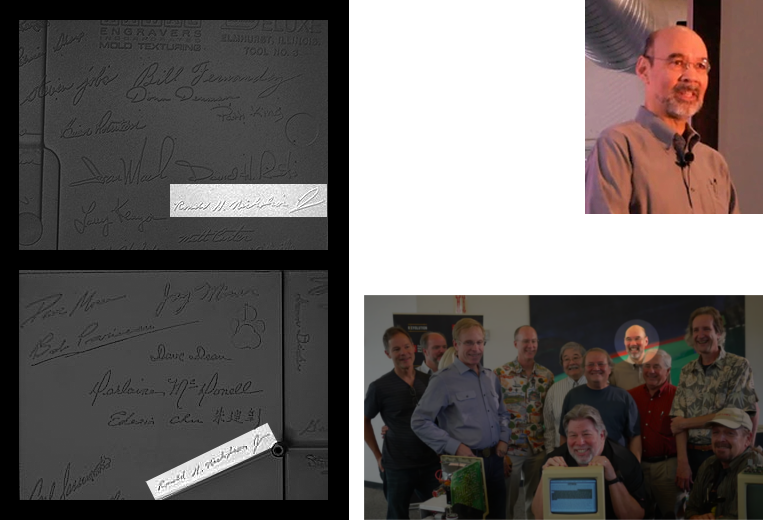Ron Nicholson, Early Mac and Amiga Engineer

Tonight I’ll be attending a presentation from Ron Nicholson, who was both a member of the original Macintosh engineering team (1980-1982) and founder and Director of Engineering of Amiga (1983-1984). I believe he’s the only person whose signature is molded into the case of the early Macintosh and the original Amiga computers. Post your questions for Ron here, and I’ll try to get answers, or see if I can entice him to come here and answer them himself.
Among his many accomplishments, at Apple Ron was an IWM ASIC project engineer and Apple II peripheral engineer, including work on the Super Serial Card. He also worked on the CMOS clock chip for the original Macintosh. Ron has worked at several Silicon Valley companies, including Apple, Amiga, HP, Sigma Designs, and Silicon Graphics. Ron has contributed to the design of FPGAs, network ASICs, RISC workstations, the Nintendo 64, the original Apple Macintosh, and the Commodore Amiga. Ron is named as co-inventor on 11 U.S. patents, including several on the architecture of the Amiga 1000. http://www.nicholson.com/rhn/index.html
Read 3 comments and join the conversation3 Comments so far
Leave a reply. For customer support issues, please use the Customer Support link instead of writing comments.


Ron shared some interesting stories. My favorite was how Apple approached FCC certification of RF emissions for the Apple II. Apple needed an “RF quiet” location where they could carefully measure the emissions from a test machine without polluting the measurements with other ambient RF noise. Today this is usually done in a very expensive and specialized test facility, but Apple didn’t have the resources for that back then. So they scouted around and found a steep ravine in a rural part of Pacifica, a small town between Cupertino and San Francisco. This location was far from any power lines, electric appliances, or other local sources of RF noise, and the ravine helped to block RF signals from more distant sources. Apple rented a farm field at the bottom of the ravine, and set up an RF test station in the middle of the field, with an Apple II test unit lots of specialized test hardware. I have to laugh, imagining these Apple engineers working furiously in a makeshift open-air electronics lab in a strawberry field at the bottom of a ravine in the middle of nowhere.
We also enjoyed some stories and commentary about the development of the first Macintosh. As Ron tells it, there was lots of furious hardware experimentation with wire-wrapped prototypes, looking for ways to extend the Mac’s capability. One day one of the hardware engineers (I think Ron said it was Burrell Smith) was tinkering with the possibility of adding color capability to the Mac prototype, and and was building out the required circuitry on a wire-wrap board. Steve Jobs came along and asked what he was doing. When he heard it was an experiment for adding color, Jobs got very upset and yelled “the Macintosh will be a black and white machine!”, then stormed out of the lab. The work-in-progress color circuitry was quietly dismantled.
The Apple II RF testing in a farm field also reminds me of a story that my wife heard when she was in graduate school. I’m probably getting the details wrong, but the story concerned some scientists doing an archeological expedition looking for underground structures. They were towing a sensitive RF instrument back and forth across a field – possibly a magnetometer or ground-penetrating radar. But they were getting so much RF noise from their trucks and tractors that it overwhelmed the signals they were looking for. After trying a number of possible fixes, they eventually gave up on the trucks and used a team of donkeys pulling a cart. Problem solved.
Great stories, thanks for sharing!